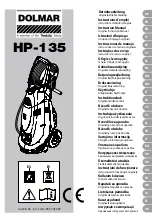
18
31
SYMBOLE
SYMBOLE PALABRA SIGNIFICADO
PELIGRO
Indica una inminente situación de peligro que, en caso de no evitarse,
provocará la muerte o lesiones graves.
ADVERTENCIA
Indica una posible situación de peligro que, en caso de no evitarse,
puede provocar la muerte o lesiones graves.
PRECAUCIÓN
Indica una posible situación de peligro que, en caso de no evitarse,
puede provocar lesiones leves o poco graves.
PRECAUCIÓN
Sin símbolo de advertencia de seguridad) Indica una situación que
puede provocar daños en la propiedad.
Las siguientes palabras de advertencia y sus significados se indican con el propósito de
explicar los niveles de riesgo relacionados con este producto.
ELECTRICAL
DOUBLE INSULATION
Double insulation is a concept in safety in electric power tools, which eliminates
the need for the usual three-wire grounded power cord. All exposed metal parts
are isolated from the internal metal motor components with protecting insulation.
Double insulated products do not need to be grounded.
WARNING:
The double insulated system is intended to protect the user from shock resulting
from a break in the product’s internal insulation. Observe all normal safety precau-
tions to avoid electrical shock.
NOTE:
Servicing of a product with double insulation requires extreme care and
knowledge of the system and should be performed only by a qualified service tech-
nician. For service, we suggest you return the product to your nearest authorized
service center for repair. Always use original factory replacement parts when ser-
vicing.
ELECTRICAL CONNECTION
This product has a precision-built electric motor. It should be connected to a
power supply that is 120 volts, AC only (normal household current), 60 Hz.
Do not operate this product on direct current (DC). A substantial voltage drop will
cause a loss of power and the motor will overheat. If the product does not operate
when plugged into an outlet, double-check the power supply.
ExTENSION CORDS
When using a power tool at a considerable distance from a power source, be sure
to use an extension cord that has the capacity to handle the current the product
will draw. An undersized cord will cause a drop in line voltage, resulting in over-
heating and loss of power. Use the chart to determine the minimum wire size
required in an extension cord. Only round jacketed cords listed by Underwriter’s
Laboratories (UL) should be used.
When working outdoors with a product, use an extension cord that is designed for
outside use. This type of cord is designated with “WA” or “W” on the cord’s jacket.
Before using any extension cord, inspect it for loose or exposed wires and cut or
worn insulation.
OPERATION CONTINUED
• Pour detergent into tank.
NOTE:
Use a funnel, if needed, to prevent accidental spilling of the detergent out-
side the tank. If any detergent is spilled during the filling process, make sure the
unit is cleaned and dried before proceeding.
• Reinstall cap.
PUMP LUBRICANT
The pressure washer pump has been filled with sufficient lubricant at the factory
and is maintenance free. You do not need to check or add lubricant to the pump
before initial use.
STARTING AND STOPPING THE PRESSURE WASHER
See Figure 11.
CAUTION:
Do not run the pump without the water supply connected and turned on.
• Connect the garden hose.
• Turn the garden hose on then squeeze the trigger to relieve air pressure. Once a
steady stream of water appears, release the trigger.
• After ensuring the On/Off switch is in the OFF ( O ) position, connect the pressure
washer to the power supply.
• Press the reset button on the pressure washer’s plug to make sure the unit is
ready for operation.
• Press
ON ( I )
on the switch to start the motor.
• To stop the motor, release the trigger and press
OFF ( O )
on the switch.
NOTE:
The pressure washer may be on and the system may have pressure even
when the pump and/or motor cannot be heard running. Always use caution around
the pressure washer.
WARNING:
Hold the trigger handle securely with both hands. Expect the trig-
ger handle to move when the trigger is pulled due to reaction forces. Failure to do
so could cause loss of control and injury to yourself and others.
USING THE TRIGGER AND LOCK-OUT
See Figure 12.
For greater control and safety, keep both hands on the trigger handle at all times.
• Pull back and hold the trigger to operate the pressure washer.
• Release the trigger to stop the flow of water through the nozzle.
TO ENGAGE THE LOCK-OUT:
• Pull the lock-out lever toward the grip on the handle until it snaps into place in
the groove.
TO DISENGAGE THE LOCK-OUT:
• Push the trigger forward slightly to free the lock-out lever from the groove. Put
the lever back into place on the trigger.
For the most effective cleaning, the nozzle end of the spray wand should be
between 8 in. and 24 in. from the surface to be cleaned. If the spray is too close it
can damage the cleaning surface.
USING THE NOZZLES
See Figure 13.
Each of the nozzles has a different spray pattern. Before starting any cleaning job,







































